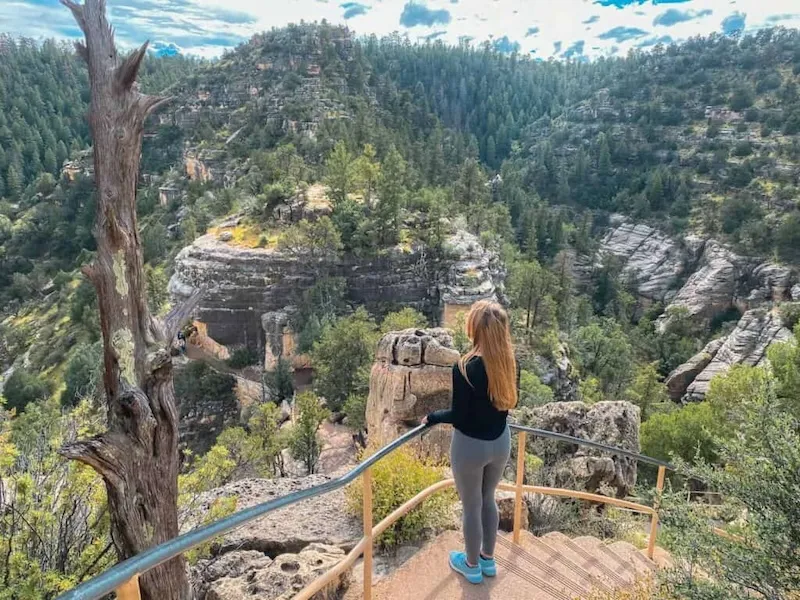Arizona, renowned for its majestic natural landscapes and unique indigenous culture, is a dream destination for travelers. If you’re planning a trip to this captivating state, don’t miss the opportunity to explore Walnut Canyon National Park, a hidden gem boasting distinctive beauty and a rich history.
Walnut Canyon: A Journey Back in Time
Walnut Canyon National Park is not only an appealing tourist spot but also a living museum, preserving the vestiges of the ancient Sinagua civilization. Here, you can marvel at the unique cliff dwellings, learn about the life and culture of the Sinagua people, and immerse yourself in the pristine beauty of Walnut Canyon.
I. The Underlying Beauty of Walnut Canyon
1. Sinagua Cultural Heritage
Walnut Canyon was once inhabited by the Sinagua people from around 1100 to 1250 AD. They built small stone houses in natural alcoves in the canyon walls, utilizing the terrain to create unique and fortified settlements.

Today, visitors can explore these ruins via the Island Trail, a 1.6 km (1-mile) loop trail that descends into the canyon and allows you to observe the cliff dwellings up close.
2. Island Trail: Path of Discovery
The Island Trail is the most famous trail in Walnut Canyon, offering visitors a rare opportunity to step into the world of the Sinagua people. This trail has a moderate slope, but in return, you’ll witness ancient cliff dwellings, learn about the unique construction techniques of the Sinagua, and discover how they survived in a harsh environment.

3. Rim Trail: Panoramic Views
If you prefer not to descend into the canyon, the Rim Trail is an excellent option for admiring panoramic views of Walnut Canyon from above. This trail runs along the canyon rim, offering stunning perspectives down into the canyon, where the cliff dwellings are nestled among the steep cliffs.

4. Natural Beauty
Besides the historical relics, Walnut Canyon possesses unspoiled natural beauty. The canyon was formed by the flow of water over millions of years, creating steep cliffs, unique rock formations, and rich vegetation.

II. Walnut Canyon National Park Visitor Experience
1. Ideal Time to Visit
The best times to visit Walnut Canyon are spring (March – May) and fall (September – November), when the weather is cool and pleasant. In summer, temperatures can reach 40°C (104°F), making hiking difficult. Winter can be cold and snowy, but it offers a different kind of beauty to the canyon.
2. Getting There
Walnut Canyon is located about 16 km (10 miles) east of Flagstaff. You can easily get there by private car or rental car. There are also some tours from Flagstaff to Walnut Canyon.
3. Preparation
When visiting Walnut Canyon, you should bring water, sunscreen, a hat, and comfortable walking shoes. If you plan to hike, prepare hiking poles and a map.
4. Important Notes
- Respect the cultural heritage of the Sinagua people by not touching or removing anything from the archaeological sites.
- Stay on marked trails and follow park regulations.
- Pay attention to the weather and be prepared for unexpected changes.
III. Guided Tours of Walnut Canyon National Park
For a complete and meaningful Walnut Canyon experience, you can choose to join guided tours. These tours are usually organized by local tour companies or by the national park itself.

1. Guided Walking Tours
Guided walking tours are usually offered daily and last about 2-3 hours. Guides will provide you with detailed information about the history and culture of the Sinagua, as well as the flora and fauna of Walnut Canyon.
2. Electric Rim Trail Tours
If you don’t want to walk much, you can choose an electric Rim Trail tour. The electric vehicle will take you along the Rim Trail, allowing you to admire panoramic views of Walnut Canyon comfortably and easily.
3. Special Tours
In addition to regular tours, Walnut Canyon also organizes special tours, such as stargazing tours, geology tours, and children’s tours.
IV. Combining a Visit to Walnut Canyon with Other Destinations
If you have more time, you can combine a visit to Walnut Canyon with other attractions in Arizona, such as:
- Grand Canyon: One of the seven natural wonders of the world.
- Sedona: A town famous for its red rock mountains and spiritual energy.
- Flagstaff: A beautiful university city with many outdoor activities.
- Meteor Crater: The best-preserved large meteor crater on Earth.
V. Conclusion
Walnut Canyon National Park is a unique and fascinating tourist destination in Arizona, where you can explore the history, culture, and natural beauty of this region. With the information and travel tips shared in this article, we hope you will have a memorable trip to Walnut Canyon. Plan your visit today and prepare for an unforgettable adventure!